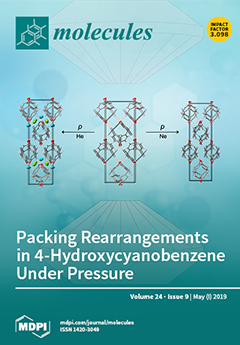Voltammetry provides important information on the redox properties of catalysts (transition metal complexes of Ni, Co, Mn, etc.) and their activity in electrocatalytic reactions of aromatic C–H phosphonation in the presence of a phosphorus precursor, for example, dialkyl-
H-phosphonate. Based on catalytic
[...] Read more.
Voltammetry provides important information on the redox properties of catalysts (transition metal complexes of Ni, Co, Mn, etc.) and their activity in electrocatalytic reactions of aromatic C–H phosphonation in the presence of a phosphorus precursor, for example, dialkyl-
H-phosphonate. Based on catalytic current growth of oxidation or reduction of the metal catalysts (Co
II, Mn
II, Ni
II, Mn
II/Ni
II, Mn
II/Co
II, and Co
II/Ni
II), quantitative characteristics of the regeneration of catalysts were determined, for example, for Mn
II, Ni
II and Mn
II/Ni
II, Co
II/Ni
II pairs. Calculations confirmed the previously made synthetic observations on the synergistic effect of certain metal ions in binary catalytic systems (Mn
IIbpy/Ni
IIbpy and Ni
IIbpy/Co
IIbpy); for mixtures, the observed rate constants, or TOF, were 690 s
−1 and 721 s
−1, respectively, and product yields were higher for monometallic catalytic systems (up to 71% for bimetallic catalytic systems and ~30% for monometallic catalytic systems). In some cases, the appearance of pre-waves after adding
H-phosphonates confirmed the preceding chemical reaction. It also confirmed the formation of metal phosphonates in the time scale of voltammetry, oxidizing or reducing at lower potentials than the original (RO)
2P(O)H and metal complex, which could be used for fast diagnostics of metal ion and dialkyl-
H-phosphonate interactions. Electrochemical transfer of an electron to (from) metal phosphonate generates a phosphonyl radical, which can then react with different arenes to give the products of aromatic C–H phosphonation.
Full article






